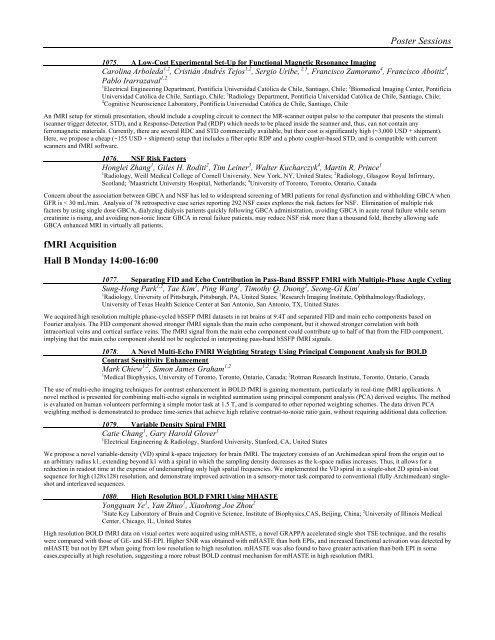TRADITIONAL POSTER - ismrm
TRADITIONAL POSTER - ismrm
TRADITIONAL POSTER - ismrm
Create successful ePaper yourself
Turn your PDF publications into a flip-book with our unique Google optimized e-Paper software.
Poster Sessions<br />
1075. A Low-Cost Experimental Set-Up for Functional Magnetic Resonance Imaging<br />
Carolina Arboleda 1,2 , Cristián Andrés Tejos 1,2 , Sergio Uribe, 2,3 , Francisco Zamorano 4 , Francisco Aboitiz 4 ,<br />
Pablo Irarrazaval 1,2<br />
1 Electrical Engineering Department, Pontificia Universidad Católica de Chile, Santiago, Chile; 2 Biomedical Imaging Center, Pontificia<br />
Universidad Católica de Chile, Santiago, Chile; 3 Radiology Department, Pontificia Universidad Católica de Chile, Santiago, Chile;<br />
4 Cognitive Neuroscience Laboratory, Pontificia Universidad Católica de Chile, Santiago, Chile<br />
An fMRI setup for stimuli presentation, should include a coupling circuit to connect the MR-scanner output pulse to the computer that presents the stimuli<br />
(scanner trigger detector, STD), and a Response-Detection Pad (RDP) which needs to be placed inside the scanner and, thus, can not contain any<br />
ferromagnetic materials. Currently, there are several RDC and STD commercially available, but their cost is significantly high (~3,000 USD + shipment).<br />
Here, we propose a cheap (~155 USD + shipment) setup that includes a fiber optic RDP and a photo coupler-based STD, and is compatible with current<br />
scanners and fMRI software.<br />
1076. NSF Risk Factors<br />
Honglei Zhang 1 , Giles H. Roditi 2 , Tim Leiner 3 , Walter Kucharczyk 4 , Martin R. Prince 1<br />
1 Radiology, Weill Medical College of Cornell University, New York, NY, United States; 2 Radiology, Glasgow Royal Infirmary,<br />
Scotland; 3 Maastricht University Hospital, Netherlands; 4 University of Toronto, Toronto, Ontario, Canada<br />
Concern about the association between GBCA and NSF has led to widespread screening of MRI patients for renal dysfunction and withholding GBCA when<br />
GFR is < 30 mL/min. Analysis of 78 retrospective case series reporting 292 NSF cases explores the risk factors for NSF. Elimination of multiple risk<br />
factors by using single dose GBCA, dialyzing dialysis patients quickly following GBCA administration, avoiding GBCA in acute renal failure while serum<br />
creatinine is rising, and avoiding non-ionic linear GBCA in renal failure patients, may reduce NSF risk more than a thousand fold, thereby allowing safe<br />
GBCA enhanced MRI in virtually all patients.<br />
fMRI Acquisition<br />
Hall B Monday 14:00-16:00<br />
1077. Separating FID and Echo Contribution in Pass-Band BSSFP FMRI with Multiple-Phase Angle Cycling<br />
Sung-Hong Park 1,2 , Tae Kim 1 , Ping Wang 1 , Timothy Q. Duong 2 , Seong-Gi Kim 1<br />
1 Radiology, University of Pittsburgh, Pittsburgh, PA, United States; 2 Research Imaging Institute, Ophthalmology/Radiology,<br />
University of Texas Health Science Center at San Antonio, San Antonio, TX, United States<br />
We acquired high resolution multiple phase-cycled bSSFP fMRI datasets in rat brains at 9.4T and separated FID and main echo components based on<br />
Fourier analysis. The FID component showed stronger fMRI signals than the main echo component, but it showed stronger correlation with both<br />
intracortical veins and cortical surface veins. The fMRI signal from the main echo component could contribute up to half of that from the FID component,<br />
implying that the main echo component should not be neglected in interpreting pass-band bSSFP fMRI signals.<br />
1078. A Novel Multi-Echo FMRI Weighting Strategy Using Principal Component Analysis for BOLD<br />
Contrast Sensitivity Enhancement<br />
Mark Chiew 1,2 , Simon James Graham 1,2<br />
1 Medical Biophysics, University of Toronto, Toronto, Ontario, Canada; 2 Rotman Research Institute, Toronto, Ontario, Canada<br />
The use of multi-echo imaging techniques for contrast enhancement in BOLD fMRI is gaining momentum, particularly in real-time fMRI applications. A<br />
novel method is presented for combining multi-echo signals in weighted summation using principal component analysis (PCA) derived weights. The method<br />
is evaluated on human volunteers performing a simple motor task at 1.5 T, and is compared to other reported weighting schemes. The data driven PCA<br />
weighting method is demonstrated to produce time-series that achieve high relative contrast-to-noise ratio gain, without requiring additional data collection.<br />
1079. Variable Density Spiral FMRI<br />
Catie Chang 1 , Gary Harold Glover 1<br />
1 Electrical Engineering & Radiology, Stanford University, Stanford, CA, United States<br />
We propose a novel variable-density (VD) spiral k-space trajectory for brain fMRI. The trajectory consists of an Archimedean spiral from the origin out to<br />
an arbitrary radius k1, extending beyond k1 with a spiral in which the sampling density decreases as the k-space radius increases. Thus, it allows for a<br />
reduction in readout time at the expense of undersampling only high spatial frequencies. We implemented the VD spiral in a single-shot 2D spiral-in/out<br />
sequence for high (128x128) resolution, and demonstrate improved activation in a sensory-motor task compared to conventional (fully Archimedean) singleshot<br />
and interleaved sequences.<br />
1080. High Resolution BOLD FMRI Using MHASTE<br />
Yongquan Ye 1 , Yan Zhuo 1 , Xiaohong Joe Zhou 2<br />
1 State Key Laboratory of Brain and Cognitive Science, Institute of Biophysics,CAS, Beijing, China; 2 University of Illinois Medical<br />
Center, Chicago, IL, United States<br />
High resolution BOLD fMRI data on visual cortex were acquired using mHASTE, a novel GRAPPA accelerated single shot TSE technique, and the results<br />
were compared with those of GE- and SE-EPI. Higher SNR was obtained with mHASTE than both EPIs, and increased functional activation was detected by<br />
mHASTE but not by EPI when going from low resolution to high resolution. mHASTE was also found to have greater activation than both EPI in some<br />
cases,especially at high resolution, suggesting a more robust BOLD contrast mechanism for mHASTE in high resolution fMRI.















